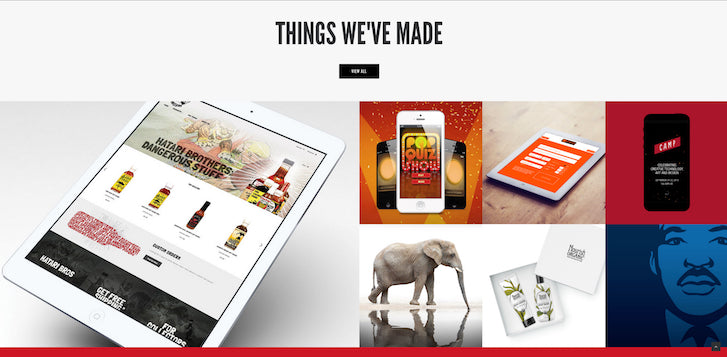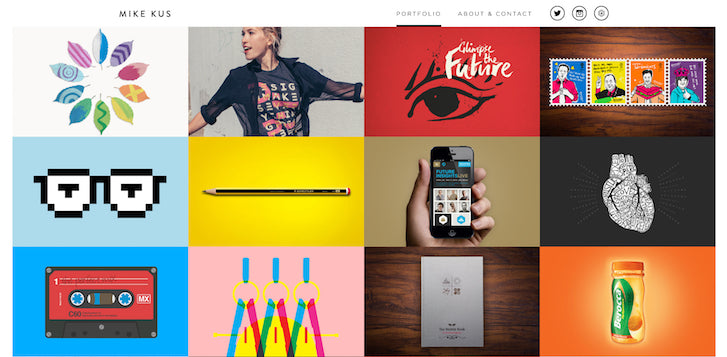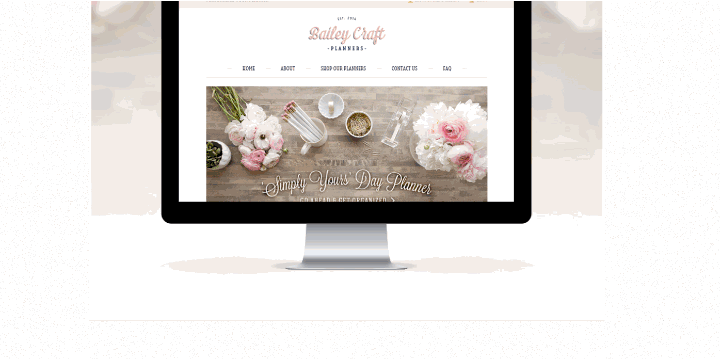Starting your career as a young designer is a daunting task. You may have worked with one or two clients, or perhaps you’re struggling to land your first contract. Maybe you are trying to find a position at an agency, but you are having a hard time articulating your value.
Whatever the case, having a solid design portfolio will help you communicate your skills and expertise, and give you the confidence you need to sell yourself to a potential client or a future employer.
Shopify has a number of experienced designers who all started somewhere. Today they're sharing their advice to young designers on what makes a great design portfolio. Here’s what they had to say:


You might also like: How to Create a Compelling Web Design Portfolio.
Show the kind of work you aspire to do
 Ask yourself what you really care about, and select work that will reflect where your interests lie. Your portfolio should include projects that best showcase your abilities, and demonstrate the kind of work you would like to keep doing more of. Self-initiated projects are a great way to demonstrate what you’re truly passionate about if you lack experience in the field you are looking to move into.
Ask yourself what you really care about, and select work that will reflect where your interests lie. Your portfolio should include projects that best showcase your abilities, and demonstrate the kind of work you would like to keep doing more of. Self-initiated projects are a great way to demonstrate what you’re truly passionate about if you lack experience in the field you are looking to move into.
“It will be tempting to include everything you've ever created to show your diversity. If you're not 100 per cent convinced it is great work — don't! Try to find your voice and then use your portfolio to showcase it. If you show something to a client that you don't love, that client might hire you then to do more work that you don't love. And that can turn into a vicious circle.”
"You're judged by the worst piece of work in your portfolio, not your best. Choose your pieces wisely and be critical and selective about what you include."
Constantly improve your portfolio
 It may seem obvious but you need to keep your portfolio updated. Your portfolio is a living object — it should grow as you grow. Keep it current, add new projects, and improve or remove outdated work regularly.
It may seem obvious but you need to keep your portfolio updated. Your portfolio is a living object — it should grow as you grow. Keep it current, add new projects, and improve or remove outdated work regularly.
"ABC — Always be creating. Keep that work flowing into your portfolio. Sometimes you’ll get a lull in your day-to-day work, sometimes that lull can last six months or more. If you’re not creating work, then your portfolio will sit empty and become stale."
"A wise friend once said to me 'You’re only as good as your last piece of work.' Your portfolio is a representation of your skills. Make sure to keep your portfolio up-to-date."
Explain your process
 The most unanimous piece of advice is to include context, process, and a design rationale for every project. Showcase how you work and how you solve problems. Specify what you were in charge of. Be critical and explain what you would do differently today.
The most unanimous piece of advice is to include context, process, and a design rationale for every project. Showcase how you work and how you solve problems. Specify what you were in charge of. Be critical and explain what you would do differently today.
"Case studies are the best way to show your work. Outline the challenges of the project, and then tell the story of how you arrived at the solution. Bonus points for sharing wireframes, sketches, and in-process work."
“Show your work. I mean that in the same sense as math class. I care a lot less about what the final product looks like than I do about how you got there. Every piece in your portfolio should include a case study that walks through every step you took to success. Include failed attempts. The best thing I ever saw in a portfolio, was a case study that included a post-mortem. After the project launched, the designer included a breakdown of what parts of the project were successful, what parts weren't, and how they took that as feedback to make the project better.”
"When I’m looking at a piece, I want to understand the context of the project, the process, who collaborated with you, and if it’s a team effort what part you were specifically responsible for. A great case study will be ten times more effective than a simple mock. And don’t forget words. A portfolio without words is like a resume without dates."
“Writing is an important part of a great portfolio. A successful designer knows how to talk about their design process. What research did you do and why? What deliverables did you produce and why? How did you know when to increase the fidelity of your work? How did you prototype animations and transitions? What were some of the pitfalls of your process? Be honest and we’ll walk away impressed.”
Keep it simple
 Your portfolio should be easy to navigate. Don’t overdesign it. Remember: you’re trying to display your work, not the window dressing around it. Anything that distracts the viewer from understanding your skill set or what you’ve worked on, needs to go.
Your portfolio should be easy to navigate. Don’t overdesign it. Remember: you’re trying to display your work, not the window dressing around it. Anything that distracts the viewer from understanding your skill set or what you’ve worked on, needs to go.
"Start strong. End strong. The best designers take great care of the overall portfolio experience, with a flow that makes you go from 'wow' to 'WOW' to 'Holy ****!'"
“The experience of reviewing a designer’s work should be effortless and the presentation of the portfolio should focus on the work itself.”
“It’s easy to get lost in designing your portfolio, but I usually don’t mind what tool is used to display it. A simple Behance portfolio will sometimes work better than a parallax custom-made portfolio.”
Don’ts
 Avoid spelling errors, broken links, flash, pie charts, and pretty doodles without context or purpose.
Avoid spelling errors, broken links, flash, pie charts, and pretty doodles without context or purpose.
“I don’t like infographics showing the amount of pixels, coffees, days, hair lost, during the creation of a project. If you put in a 'fun fact', it better be really fun and not something to show me you can design colorful pie charts.“
“Only having a few Dribbble shots just doesn’t cut it. How can you tell what the real experience will be like? How does a screenshot fit into a product’s larger ecosystem. Dribbble is chock full of “perfect scenario” design examples, and it's just not realistic. In the real world we deal with edge cases, dirty data, layers of states, and more. How is your perfectly designed minimalistic email client going to handle everything? Designing for aesthetics instead of functionality drives me crazy. Just because something looks pretty doesn’t mean it’s going to function well.”
And one final piece of advice...
Get your work out there, get some feedback, improve your work, and repeat.
Looking for more actionable insights from industry experts? Be sure to check out our article on Best Advice for Aspiring Freelancers from 10 Industry Experts.
Read more
- How to Build Fast and Secure Websites With the JAMstack
- 20 Memorable Web Design Portfolio Examples to Inspire Your Own Website
- How to Work With Shopify Theme Blocks
- The Benefits of Adding a Shopify Landing Page to Your Portfolio Site (and How to Make One)
- 5 Easy Ways to Make Your Portfolio Website Look Fresh
- How to Write a Business Email Prospective Clients Will Never Forget
- Cold Outreach: How to Build Warm Relationships with Potential Clients
- How Social Media Can Help You Grow Your Freelance or Agency Business
- Paul Boag on Content Marketing & How to Start Your Blog
- You’re Nothing Special: How to Stand Out in a Crowded Marketplace

